Well this week we have been offsite at the 3rd International Planetary Caves Conference held at Southwest Research Institute (SwRI) in San Antonio, TX.
I enjoyed my first time visit to SwRI and the campus environment reminded me of my previous work at one of the big oil research centers. As it turns out, SwRI was founded as an independent research facility by businessman and oilman, Tom Slick (yep, that is right) back in 1947.
 |
| Southwest Research Institute (SwRI) hosts the 3rd International Planetary Caves Conference (Source: Palmia Observatory) |
I enjoyed driving around the campus and past various buildings involved with all sorts of independently funded research in space and chemistry and defense and even still oil related research in fuels and lubricants and engine and dynomometer test facilities. This "warning" sign sort of tells the whole story of what happens when you collect 3000 workers on the campus!
 | |
|
We met in one of the main conference rooms and there were several displays and plaques showing different space research projects that SwRI has been involved with and I found this interesting poster sowing how the spacecraft Juno was depicted as unzipping some of the secrets of Jupiter.
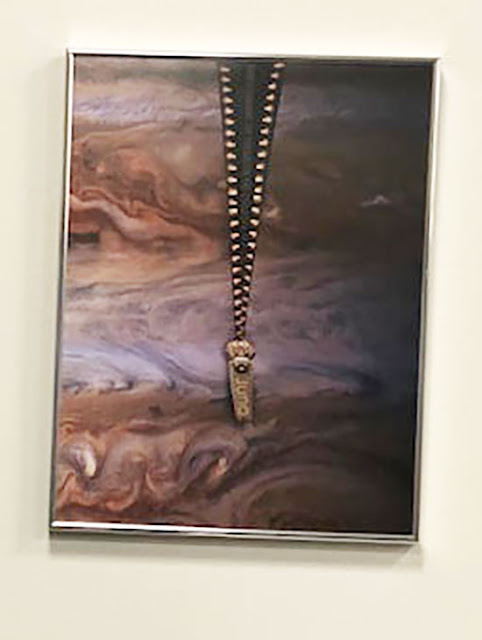 |
| SwRI poster showing interesting perspective on Juno looking inside Jupiter (Source: Palmia Observatory) |
The planetary caves conference was sponsored by the Lunar and Planetary Institute (LPI), which is managed by Universities Space Research Association (USRA) under an agreement with NASA. There were by my count about 60 attendees, of which about half were making presentations at the conference. There were several international attendees and presenters from European Space Agency (ESA) as well. Most of the attendees seemed to be either geologists, geochemists, geophysicists or astrobiologists. I enjoyed all of the presentations and found that I had to google many of the geological terms that I was not familiar with.
The conference organizers requested we not take photos of presentations unless we had specific author approval to do so. Because of this restriction my plan is to just summarize the concepts discussed there in general terms, or at least as understood by this physicist wannabe. One of the best introductory talks on the overall status of extraterrestrial cave science and exploration was given by Dr. Laura Kerber, JPL. She was an excellent speaker and you can check out her many online videos for more of the details, but she went over: (1) Why geologists and scientists want to study caves and lava tubes, (2) Why human explorers and astronauts are interested in caves, (3) Why in situ resource hunters are interested, and (4) What is holding us back from exploring the caves?
She explained that the geology of cave and tube formation tells us much about the geological processes that went during the formation of the planet and the history of climate on the planet as well. Previous astronauts on the moon could only collect regolith and other surface rocks not connected to the underlying geologic features of the moon and caves do show directly more detail about formations and processes. Caves and tubes might also harbor water, iron and titanium for in situ resource applications. Caves and lava tubes can also provide a natural habitat for protection from solar radiation, temperature variations, micrometeorites and dust.
As part of my "homework" during the breaks, I had to look up many of the unfamiliar geological terms, such as "karst". This Wikipedia sectional drawing was useful for understanding some of the processes involved with forming underground caverns and how they are mostly caused by water flow.
 |
| Many caves are formed in karst terrain as water flows along faults (Source: Wikipedia) |
Lava tubes are another common underground structure that show up on the Earth and on Mars and the Moon also. We have visited one of the lava tubes on Rapa Nui, but it was exciting to hear about great examples of lava tubes located in the Canary Islands. Flowing lava, depending on its temperature and viscosity, can carve wide channels in the surface and travel long distances. Some of the ESA presenters showed some great examples and how some of the lave tubes are used to train astronauts. Check out this example from the Lanzarote Caves website. Might have to put the Canary Islands on our travel schedule!
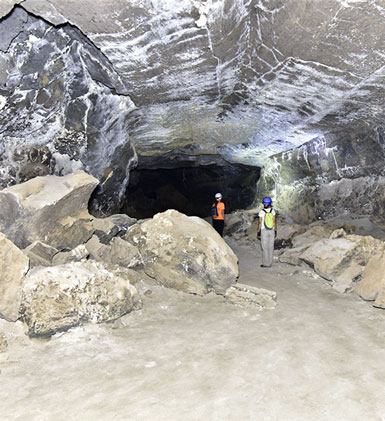 |
| An example of large larva tube on Lanzarote, one of the Canary Islands (Source: www.lanzarotescaves.com) |
There are many suspected lava tubes on the moon also. One of the best examples is in this photo of the Hadley Rille. The Moon's history includes plenty of impact craters and flowing lava.
 |
| Image of Hadley Rille taken during Apollo 15 mission (Source: Wikipedia) |
So we are lucky on the Earth that we can find areas where the lava tubes or karstic caves break through the surface and we can explore inside. But on the Moon and Mars it is harder to prove that what looks like a lava tube from remote observations is really a lava tube and not some other geologic structure. We know lava tubes on Earth often are found with skylights, areas where portions of the roof of the tube has collapsed and you can see down into the tube. One of the most exciting locations on the Moon that is being considered as a future target for exploration is this famous "hole in the Moon."
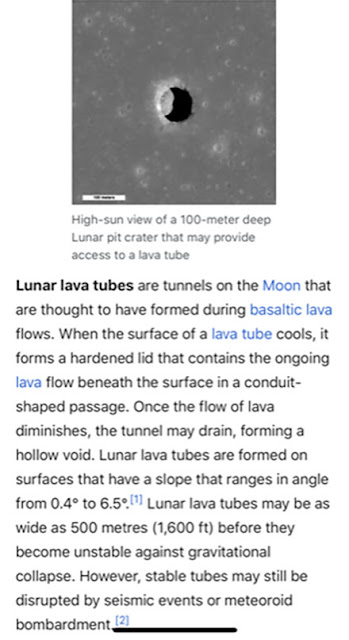 |
| One of many holes in the moon (Source: Wikipedia) |
So, now we have direct observational evidence of lava tubes on the Moon. Now there is no risk of travelling to the Moon, only to find that the lava tube is not a lava tube after all. We now can return to the question that Dr. Kerber posed earlier and review what is holding us back.
In following some of the NASA discussions about funding a mission to return to the Moon, there seems to be a difference in opinion as to whether we should aim for a lava tube, or aim for some of the craters near the poles, where you could explore for and hopefully find water. Finding water on the Moon would be a giant step forward to having a more long term presence on the Moon. Some of the craters expected to contain ice in the permanently shaded portions of the crater also have the feature of having some of the crater rim permanently exposed to the sun. This feature enables the search for ice and at the same time enables solar power production continuously. Otherwise, a landing at the hole would required a mission that can be completed during one of the Moon's 14 day long illuminated periods and then be complete or be able to survive the 14 day long nighttime. Some rovers, like the current rover from China, are designed to survive the long nighttime and bootup safely when the sun returns, and the rover has already successfully demonstrated that it works, but this makes for a more expensive design and mission.
We should also recall that the presence of ice in solar protected regions of craters has not been demonstrated, other than the radar imaging that seems to suggest the presence of hydrogen at those locations. One of the presenters mentioned again the 1961 paper by Watson et al, that showed that ice could be stable in a vacuum for billions of years if the temperature were low enough. We first learned of this paper by chance encountering Ken Watson himself while walking his dog, Macallan, as described in our blog post of August 12, 2019. One 1999 paper, by A. Vasavada et al, that I found that mentioned this original study is shown below. Note for temperatures below about 110 K, he evaporation rate is so low that the ice can remain in place for billions of years.
 |
| Another reference to the original 1961 paper showing ice could be present (Source: A. Vasavada et al, www.idealibrary.com) |
At the same time, travelling to a lava tube hole is difficult because of the need to land very close to the target, There apparently is a lot of progress in perfecting the capability of decreasing the size of the spacecraft landing ellipse.
Dr. Kerber has been successful in moving a proposal, called Moon Diver, through NASA review and hopes to have an actual mission in 2025 time frame. Check out the view of a wheeled rover that would travel across the surface to the hole and then repel down into the hole on a tether which would provide communications and power from the surface lander.
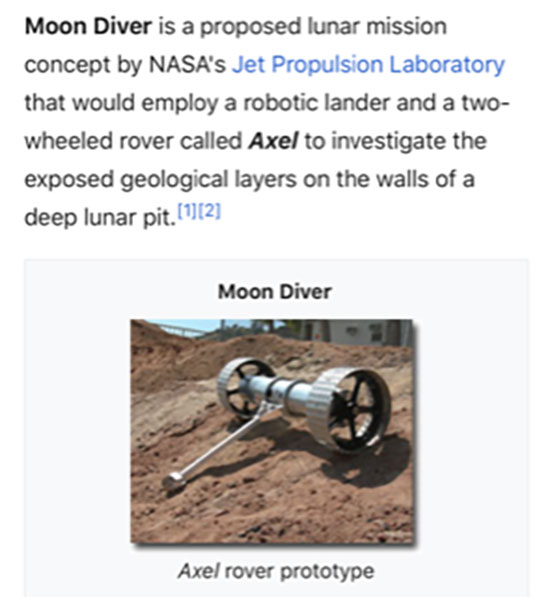 |
| Proposed NASA Axel rover that uses tether to repel into lunar pits (Source: Wikipedia) |
In a separate video available online, you can see an artist's impression of the wheeled rover descending down the hole, while doing geological investigation and measurement of the side walls. Pretty neat!
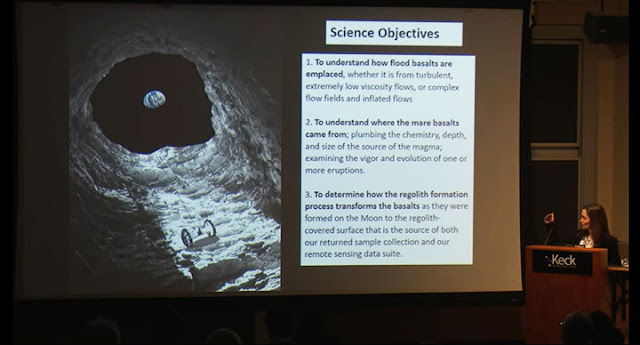 |
| Dr. Laura Kerber with artist's impression of Moon Diver and scientific goals (Source: Keck Lecture series) |
The 2nd day of the conference included a tour of the nearby Natural Bridge Caverns just a dozen miles from downtown San Antonio. This is a tourist cave and you can easily walk along a paved path and see all of the beautiful features in this karst cave. The natural bridge, shown in the photo, is part of the cave roof that has not collapsed.
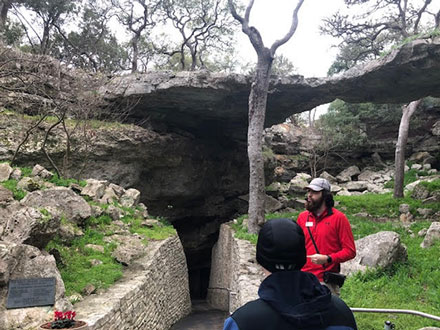 |
| Tour guide, Jonathan leads us into the Natural Bridge Caverns (Source: Palmia Observatory) |
So about half of the conference attendees showed up for this optional tour. Many members of the tour have their own favorite caves that they return to year after year to collect more samples for their research, but they still enjoy visiting tourist caves like this one.
 |
| One conference group at the Natural Bridge Caverns. Where's Resident Astronomer George? (Source: Palmia Observatory) |
The caverns are strategically lite in places so you beautiful views of all of the cavern structures. The caverns at this time of year were quite dry, although in many places we were dripped on, but none of the large pools of water that show up during the rainier part of the year were full.
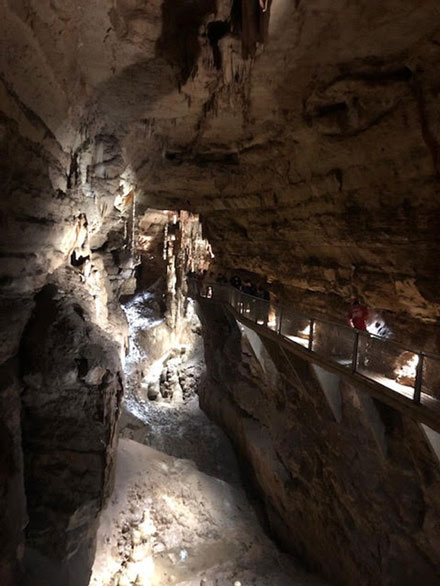 |
| Inside view of the Natural Bridge Caverns (Source: Palmia Observatory) |
This great structure is called the Kings Throne and is quite impressive. This was one of my favorites in that you see growths from the top to from the bottom.
 |
| Beautiful formations inside the Natural Bridge Caverns (Source: Palmia Observatory) |
Ok, so that is the tourist cave that we saw in the morning and in the afternoon we had an opportunity to visit a wild private cave that is also just 10-15 minutes from downtown San Antonio. This Robber Baron Cave is located on a small lot where residential homes and streets have now grown up all around the cave entrance. The cave is currently maintained by the volunteers from the Texas Cave Management Association (TCMA).
 |
| Map of the Robber Baron Cave (Source: tcmacaves.org) |
To enter this wild cave we relied on TCMA volunteers who acted as guides and provided each of use with lighted helmets, kneepads and gloves. Now I was not sure what I had signed up to do and had never done this level of caving before. When I saw the tiny narrow opening to the cave, an opening that you had to slither through on your back or on your stomach, I finally started to have my doubts if this is something I should have signed up for.
 |
| What? This is the entrance to the Robber Baron Cave! (Source: Palmia Observatory) |
Anyway, I did manage to work my way though the narrow opening into a passageway that was just a little bit wider and I had to duck and cover to prevent the helmet from continuously contacting the roof of the cave. I was probably the least experienced member of the tour so I signed up for just a quick look around. Our cave guide took us just a short distance from the entrance to the graffiti room, where various markings and signatures from visitors in the 1920's are left undisturbed. We rested a bit in this room and turned off our helmet lights and quieted down to get a sense of how isolated we were below ground. Some folks could hear their heartbeats and on occasion we could hear street traffic rumbling high above our heads.
 | |
|
There were other presentations on the interaction between biological microorganisms living in the caves and the evidence that they leave behind and how it is often hard to tell if some accretion on the cave wall is due to biology or mineralogy. Michael Spilde laid out the case for how caves provide a protected and isolated and stable environment that can support life. There can be water/ice and sources of chemical energy in lieu of light. He mentioned now how DNA sequencing of the many types of microorganisms can be used to track and differentiate those that live in caves and those that live on the surface and their is a mineral-microbe continuum between observed microbes and minerals. If the formation is due to microorganisms, there is good reason to expect there will be some sort of fossilized evidence left behind on the cave walls.
Many of the other presentations were on the instrumentation used to explore caves and map their extent. These topics were of special interest because they rely on physics principles about how electromagnetic waves interact with material atoms and molecules. One way to track lava tubes and other caves from the surface is to use ground penetrating radar (GPR). The interface between rock and void causes reflection of the radio waves that can be measured at the surface. If you have high enough power some of these measurements can be made from orbit, but the best current approach is to mount the GPR on a rover such as the Mars 2020 rover which is supposed to launch in July 2020.
 |
| Ground penetrating radar on Mars 2020 rover (Source: Wikipedia) |
Now if you have a large rover on Mars or the Moon with GPR then you can get identify substructure geologic structure, but these are expensive missions. Other approaches rely on natural radio sources. Dr. Ramano-Wolf, JPL, described one approach where radio bursts from the Sun and Jupiter can be used to examine lunar lava tubes. The more predictable radio bursts from Jupiter, in the 10-60 MHz range, of of particular use. Using these radio bursts, the detection of lave tubes can be made from orbit with a relatively cheap satellite that only has to receive the radio signals passively and does not have to transmit. After his presentation, I found this concept diagram illustrating the concept, except in this instance the passive sounding was being used to monitor the subsurface of Io. The different layers cause reflections and echos in the received signal which can be transformed into distance of the layers.
 |
| Remote sensing of subsurface structure with passive radio receivers (Source: S. Peters, et al, Stanford U) |
I was also excited to see that portable Raman spectrometers are now being used to use the vibrational modes of molecules to identify particular molecules. Joleen Csuke, Columbia U, at the conference introduced this instrument, but it was easy to find more information online. My first introduction to Raman spectrometers was in a laboratory setting where the spectrometer was this huge piano size box sitting on a heavy optical isolation bench. Wow, and now you can get a handheld spectrometer. That is pretty neat! Now scientists can just place this instrument up close to a an area of the cave wave and directly and immediately get an indication of what the material is without taking a physical sample back to the laboratory. This instrument complements the various portable x-ray spectrometers we had noticed previously.
 |
| In situ analysis of cave wall specimens with Raman spectroscopy (Source: RaPort brochure) |
There were several presentations of mapping the underground structures and caves. Dr. T. Prettyman described how monitoring of muon fluxes can be used to measure the depth below the surface. The method is to monitor the incoming muon flux on the surface and measure how the flux changes at different locations in the cave. This again is another example of using passive natural sources of incoming particles to explore subsurfaces and as I recall they were even evaluated as a tool to possibly find hidden chamber in the Great Pyramid of Egypt.
One presentation mentioned the use of LIDAR to make 3-dimensional models of caves. One example after an online search is shown in the Ouster brochure page below. As I recall, a unit similar to this can be yours for something like a mere $16k.
 |
| LIDAR tools can be used to map internal cave structure (Ouster brochure) |
Well, that is my brief summary of the conference. I have many more pages of notes that make it into a blog post sometime, but this is enough for now. I was never bored by any of the presentations, even though I did struggle with remembering some of the geological terms that were mentioned and had to look many of them up. There was some discussion that the next meeting of this international organization might take place in Europe, maybe even in the Canary Islands. Hmm, that sounds fun!
Finally, at the airport for the flight back to OC, I was amused by a handwritten addition to the operation instructions of the jet bridge at the airport. We toured a natural bridge, but what is a jumping jet bridge and what does it do?
 |
| Hmm, not sure what to make of DFW jet bridge operator instructions written with felt tip pen? (Source: Palmia Observatory) |
Until next time,
Resident Astronomer George
Be sure to check out over 400 other blog posts on similar topics
If you are interested in things astronomical or in astrophysics and cosmology
Check out this blog at www.palmiaobservatory.com

No comments:
Post a Comment